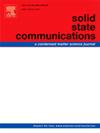单壁和多壁硼纳米管:新型DFTB参数化和电导率计算
IF 2.4
4区 物理与天体物理
Q3 PHYSICS, CONDENSED MATTER
引用次数: 0
摘要
本文提出了一种新的硼原子SCC DFTB Slater-Koster参数集。该系统提供了硼罗芬一维和二维构型原子晶格度量参数的高精度计算。考虑到所考虑的三种晶格类型的原子间键和平移向量的长度,相对于DFT方法的平均误差不超过1.69%,比使用matsci集的误差小10.7倍。应用所建立的参数化方法,得到了新的结果:a)揭示了层间键能的变化规律:随着管中层数的增加,键能的绝对值增加;b)发现单层BNT的电导率随着直径的增加而显著增加:对于直径为64.1 Å的锯齿形纳米管,由β12硼罗苯捻制,其电阻值为164.2 Ohm。硼纳米管的导电性大约是相同直径的碳纳米管的26倍。本文章由计算机程序翻译,如有差异,请以英文原文为准。
Single-walled and multi-walled boron nanotubes: Novel DFTB parameterization and electrical conductivity calculations
In this work, was developed a novel SCC DFTB Slater-Koster parameter set for boron atoms. The developed set provides high-precision calculation of the metric parameters of the atomic lattice of the 1D and 2D configuration of borophene. Taking into account the interatomic bonds and the lengths of the translation vectors for the three considered types of crystal lattice, the average error relative to DFT method is no more than 1.69 %, which is 10.7 times less than the error when using the matsci set. Applying the developed parameterization, new results were obtained: a) it was revealed a pattern of changes in the interlayer bond energy: with an increase in the number of layers in the tube, the bond energy increases in absolute value; b) it was found that with an increase in the diameter of a single-layer BNT, its electrical conductivity increases significantly: for a zigzag-type nanotube with a diameter of 64.1 Å, twisted from β12 borophene, the resistance value is 164.2 Ohm. The electrical conductivity of a boron nanotube is approximately 26 times higher than the conductivity of a carbon nanotube of the same diameter.
求助全文
通过发布文献求助,成功后即可免费获取论文全文。
去求助
来源期刊

Solid State Communications
物理-物理:凝聚态物理
CiteScore
3.40
自引率
4.80%
发文量
287
审稿时长
51 days
期刊介绍:
Solid State Communications is an international medium for the publication of short communications and original research articles on significant developments in condensed matter science, giving scientists immediate access to important, recently completed work. The journal publishes original experimental and theoretical research on the physical and chemical properties of solids and other condensed systems and also on their preparation. The submission of manuscripts reporting research on the basic physics of materials science and devices, as well as of state-of-the-art microstructures and nanostructures, is encouraged.
A coherent quantitative treatment emphasizing new physics is expected rather than a simple accumulation of experimental data. Consistent with these aims, the short communications should be kept concise and short, usually not longer than six printed pages. The number of figures and tables should also be kept to a minimum. Solid State Communications now also welcomes original research articles without length restrictions.
The Fast-Track section of Solid State Communications is the venue for very rapid publication of short communications on significant developments in condensed matter science. The goal is to offer the broad condensed matter community quick and immediate access to publish recently completed papers in research areas that are rapidly evolving and in which there are developments with great potential impact.
 求助内容:
求助内容: 应助结果提醒方式:
应助结果提醒方式:


